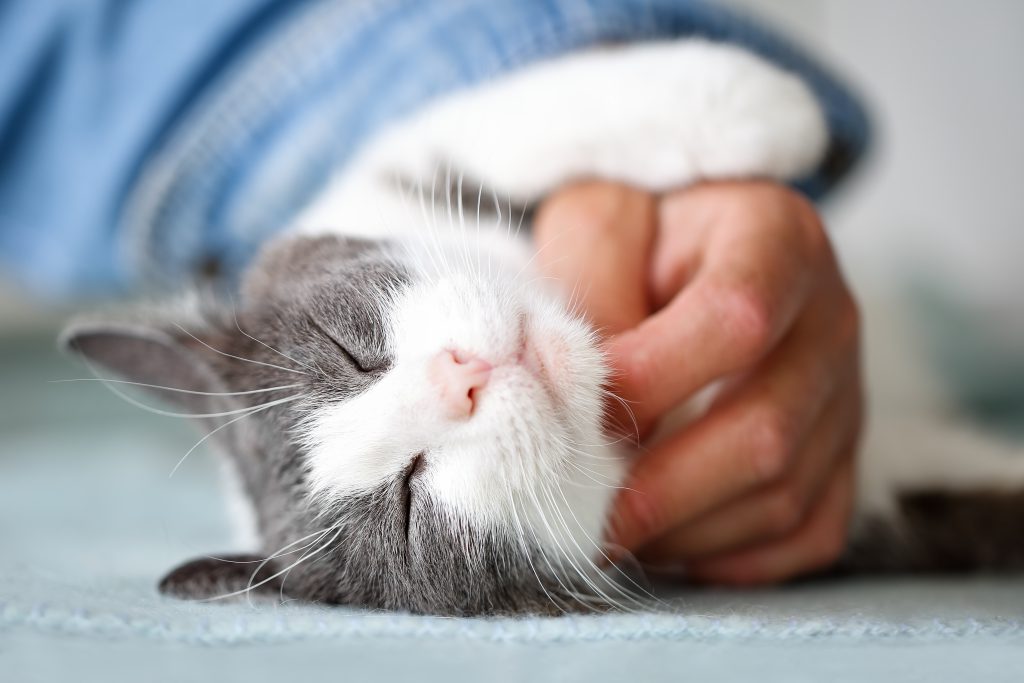
Do you have a cat that appears anxious or traumatized? It’s important to understand the origin of this behavior and how to assist your fearful or traumatized cat, as you naturally want your furry companion to feel secure with you. Here, we discuss anxious cat behavior and provide 11 tips to help a scared cat.
Similar to humans, cats have various personalities. While one cat may fear nothing, another may be easily startled. While occasional fright is normal, if a cat is consistently fearful, hiding all day, and avoids being touched, there may be an underlying issue.
It’s essential to explore ways to help your cat become more at ease. Recognizing signs of trauma in cats is crucial. These signs can range from withdrawn behavior to sudden startled reactions. Understanding these symptoms enables you to work specifically towards alleviating your cat’s anxiety.
Later in this blog, we’ll explain how to do that. But first, we’ll delve into the causes of their behavior, socialization, building trust, dealing with fearful cats, and understanding how they perceive the world. This will provide you with a better understanding of how to help a scared cat.
What are symptoms of a traumatized cat?
Traumatized cats often exhibit subtle symptoms indicating emotional discomfort. Recognizing these signals is crucial for providing proper support. Here are some common symptoms:
- Withdrawn behavior: Avoiding contact and hiding in secluded places.
- Excessive licking or scratching: Self-soothing through repeated licking or scratching, even without an apparent reason.
- Decreased appetite: Refusing to eat or significantly reduced food intake.
- Vocalization or silence: Extremely vocal behavior or conspicuous silence as a response to stress.
- Inappropriate elimination: Sudden instances of not using the litter box due to emotional stress.
- Changes in sleep pattern: Sleep disturbances or excessive sleep as a coping mechanism.
- Sensitivity to stimuli: Extreme reactions to sounds or movements in the environment.
- Aggressive behavior: Growling, hissing, scratching, or biting as an expression of fear.
- Avoidant behavior: Avoiding situations or people that previously posed no problems.
- Decreased interaction: Reduction in general interaction, such as avoiding eye contact or ignoring usual toys.
If you notice any of these signs in your cat, patience and professional advice are essential to help your cat recover and provide a safe environment.
Causes of fearful and anxious behavior in cats
Heredity of character
Just like humans, cats can also inherit character traits from their parents. So, if your cat’s mother or father is a fearful cat, the likelihood is high that your cat will also have a timid character.
Negative past experiences
Cats remember unpleasant experiences. For instance, if your cat once got frightened by a vacuum cleaner, it might remain afraid of it forever. Similarly, if a cat has been mistreated by a human at some point in its life, the chances are high that the cat will find it challenging to trust people. Your cat has learned that humans are dangerous.
Lack of socialization and the impact of early socialization
It’s crucial for kittens to come into contact with humans, other animals, and the sounds of a normal household in the first eight weeks of their lives. This helps them learn what is considered ‘normal’ and non-threatening. However, for kittens growing up as stray cats, the situation may be different.
They might not have learned to trust people, making them feel unsafe in a domestic environment. Nevertheless, there is hope: with dedication and patience, behavior experts or foster families can often socialize older cats.
Early socialization plays a crucial role in the development of cats. Positive interactions with people, other animals, and everyday sounds in the first weeks of their lives contribute to shaping confident and socially adapted pets. For kittens that are fearful, especially in a new home, early socialization can be the key to a smoother transition.
It’s essential to handle them calmly and patiently, gradually introducing them to new environments and slowly building trust. This approach becomes even more critical for kittens that are fearful, especially in an unfamiliar living environment. They deserve extra care and dedication to provide a healthy and positive socialization experience.
How a cat experiences the world
First and foremost, it’s important to understand how incredibly well cats can hear. A young cat can hear up to five times better than humans. In other words, a sound that we hear, a cat hears five times louder. A normal household sound, like a vacuum cleaner, a crying or screaming child, loud music, or something falling on the ground, is much more intense for a cat than for us. So, it’s not surprising that cats startle easily or find loud noises unpleasant.
Cats are much smaller than humans and prefer to observe new people from a distance first. If an unknown adult or a lively child suddenly pets or lifts your cat, it’s very threatening for the cat. After all, they haven’t had the chance to calmly observe who this new person is from a distance. And whether they can be trusted.

How to help a cat be less afraid
Now that you know that a cat can be afraid and why, understanding that a cat’s hearing is much stronger, and that they always feel smaller and more vulnerable than you, you’ll likely understand that you need to take that into account. Especially if you have a fearful or anxious cat at home.
11 tips to help a fearful cat
- An unsocialized cat needs a lot of time to get used to the new environment and all family members. It’s important to give a new fearful cat time and space for this adjustment, even if it takes years. Patience is crucial, but every cat is undoubtedly worth it!
- Do you have other pets? It’s good to let your cat explore the house first while keeping the other pets in a separate room.
- Explain to children that they shouldn’t just pick up or pet the cat. They can only do so when the cat comes to them, if the cat enjoys it, and when you are present.
- Convey the same message to visitors.
- Planning to vacuum? Ensure that your cat can retreat to a quiet room or go outside.
- Cats need to scratch something every day because it makes them happy and calm. Therefore, always ensure you have a good cat tree at home.
- A renovation at home causes unrest and noise. During a renovation, it’s best to bring your cat to another place – a comfortable (known) shelter is good. But it’s better if your cat can stay with familiar friends or family. If this isn’t possible, make sure your cat can go outside at least.
- Don’t play music too loud at home. If you feel like dancing in your living room, close the door to the room where your cat is staying to keep it quiet there.
- Have you accidentally dropped something and your cat got scared? Comfort your cat with a soft voice and give it a reassuring pat on the head.
- Ensure there are enough places in the house where your cat can relax. High places are preferred: a high cabinet or shelf that your cat can easily reach is great. Or buy a tall scratching post with a sleeping house or lounge basket on top. Cats always feel much safer in high places.
- If you can’t get your cat used to it or if your cat remains fearful and anxious, you might consider using calming dietary supplements or scents. In this case, always seek advice from your veterinarian or a recognized cat behavior specialist.
And we conclude with the most important tip:
It’s super important never to lose your patience with a fearful cat. As we mentioned earlier, cats need a lot of time to get used to new things. This is especially true if a cat has had unpleasant experiences or has a fearful character. So remember: every small step your cat takes is a victory. For your cat, but also for you! And, of course, never forget to reward your cat with lots of love, attention, and good care. Good luck!
Learn how to remove ticks safely and effectively
Disclaimer: Petrebels is not a veterinarian or behavior specialist: all content, information, and tips on this blog are intended to inspire you and have an informative nature. If your cat has complaints or problems, and you doubt the health of your cat, always consult a veterinarian or a behavior specialist.


